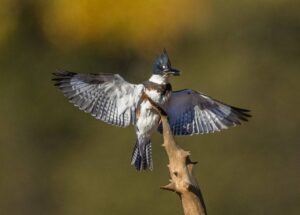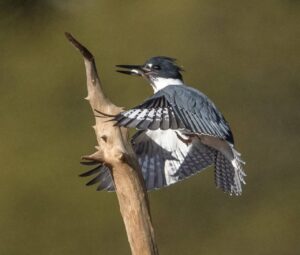We tell our students to be smart scientists, to carefully observe the world around them. But what does that really mean? What does it mean to observe?
I find that observation is an important tool both as a writer and as a nature photographer. Let me start with photography. Unless you’re taking pictures of tame ducks, swans, or household pets, wildlife can be extremely difficult to photograph. Wild creatures have more important things to do than sit around so you can photograph them. Also, the movements of birds and other animals are erratic and unpredictable, so photographing them can be frustrating. How can I photograph that bird if I have no idea what it will do or where it will go next?
In order to photograph wildlife I start by watching. And this requires patience. Careful observation helps me to learn the animal’s habits and behavior. That way I can start to anticipate what they might do next. I’ll explain how that played how while photographing this Belted Kingfisher.
Some wildlife is okay if humans are nearby, but not the kingfisher. At the first sign that a person is close, the kingfisher will fly off. I love kingfishers, so I’m eager to get a sharp image. I would love to get a shot of the kingfisher with a fish in its mouth–but how?
 Recently I was taking pictures at a pond not too far from my house. For a while nothing happened. Suddenly I heard a loud rattling–the call of the kingfisher! For the next fifteen minutes I watched it fly around. First it landed on a tree to the far left. Then the kingfisher was on a tree to the far right. I watched it over over the water, looking for a fish. Suddenly it plummeted, grab something out of the water, and flew off.
Recently I was taking pictures at a pond not too far from my house. For a while nothing happened. Suddenly I heard a loud rattling–the call of the kingfisher! For the next fifteen minutes I watched it fly around. First it landed on a tree to the far left. Then the kingfisher was on a tree to the far right. I watched it over over the water, looking for a fish. Suddenly it plummeted, grab something out of the water, and flew off.
I continued watching. There was a vertical piece of wood, about six feet high, sticking up at the back of the pond. The kingfisher landed on it. I wasn’t very close, but I could watch it through a pair of binoculars. For four or five minutes it stared intently at the surface of the water. Suddenly it dropped down, plunged underwater, and returned to the same perch with a fish in its mouth! Birds will often do this…returning to the same perch. As I watched I saw the same sequence happen again and again.
 Now I could see the pattern. The kingfisher would leave its perch, swoop down, go underwater, grab a fish, and fly back to the same perch to enjoy breakfast. I pre-focused my camera on the top of that stick, exactly where I knew the kingfisher would land. I set my shutter speed to 1/2000th of a second because a fast shutter speed is necessary to freeze a fast-flying bird.
Now I could see the pattern. The kingfisher would leave its perch, swoop down, go underwater, grab a fish, and fly back to the same perch to enjoy breakfast. I pre-focused my camera on the top of that stick, exactly where I knew the kingfisher would land. I set my shutter speed to 1/2000th of a second because a fast shutter speed is necessary to freeze a fast-flying bird.
Next time the kingfisher left to get a fish I began pressing the shutter as fast as I could. Sure enough, the bird returned to the perch and I was able to get several sharp images. See below.
When we talk to students about observation we often tell them to study small details. That’s important, but it’s more than that. Skillful observation requires us to stand back, watch over a period of time, and learn the patters of behavior that are distinctive to that creature.
One Response
Thank you for detailing your fascinating process! I’ve looked at some of your photographs and wondered “how does he do that?!”